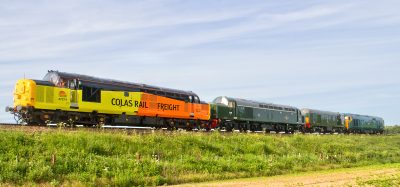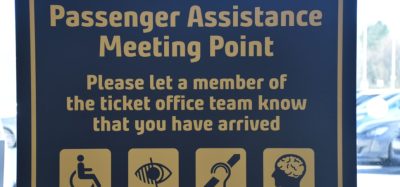Noise and vibration work in the FINE-2 project
Posted: 7 February 2022 | Scott Heath | No comments yet
Scott Heath, Coordinator of the FINE-2 project, details the project’s work around rail sector noise and vibration, and how its dedicated work packages, in conjunction with TRANSIT and SILVARSTAR, are seeking to comprehend, in fine detail, the sound generated outside of the train.


The FINE-2 project is a perfect example of the European Commission’s (EC) Horizon 2020 funding being used as it was intended – to promote collaboration in Research and Innovation activities in order to achieve greater impact. It is a collection of 14 organisations, located across seven countries, whose business activities range from train operators and infrastructure managers to research institutions and supply chain partners.
As part of the Shift2Rail Programme, the ca. €940 million public private partnership delivering research and development over a seven-year period, we interface significantly with other EC funded projects. This engagement is both circumstantial, as many of the participants are involved in other Shift2Rail work, as well as by design, as we recognised the need to work with specialist organisations outside of our consortium in order to achieve our goals. This is evident through our activities in the noise and vibration (N&V) domain, which this article will discuss, where we are working with two other consortia, TRANSIT1 and SILVARSTAR2.
Before discussing the details of the FINE‑2 work on N&V, it is worthwhile noting the final part of collaboration that exists in the project – that which is internal. We are the combination of three sub‑projects (termed work streams), each constructed of four or five discrete Work Packages (WPs). This means that experts from different domains come together to share their insights and offer best practices approaches to challenges that can be encountered.
The first work stream is focused on Energy and it seeks to help standardise the way in which energy consumption of trains is evaluated. The middle work stream (WP6‑WP10) is N&V, with the final being termed ‘Integrated Mobility Management’ or I2M. These I2M WPs are looking at the technical integrations that are needed to enable more freight transportation in a rail ecosystem that uses traffic management systems (TMS), as well as other business benefits that can be derived from interfacing TMS with other data sources.
Our work in the N&V domain is focused on improving our understanding of the sound generated outside of the train. As the name Shift2Rail suggests, the main objective is to encourage a modal shift of travellers from cars to trains. Noting this you may wonder why our work is looking at impacts external to the train carriage. After all, if we reduce the sound generated by a train passing a line-side neighbour, will it really increase the usage of trains? Rüdiger Garburg, technical leader of the work stream, provided a clear answer to this challenge: “We are going to need to keep improving the railway to attract customers, and some of this will involve construction. In democratic systems you need the support of local people to make these changes, otherwise everything will be harder to do. We get their support by demonstrating clear improvements, and one of the best ways to do this is to say: ‘we are making this railway line so many decibels quieter’ or ‘we can guarantee trains passing will generate fewer vibrations’.”
To help provide tangible and reliable benefits from train and infrastructure enhancements, the work stream is supporting the generation of new modelling tools that are developed by the SILVARSTAR project. This technology will be a step change in those available today and the first of its kind to be railway specific. Alongside this, we are hoping to reduce the costs and improve the processes associated with rolling stock acoustic certification by enabling it to take place in a virtual environment. This would also reduce the time to market for newer trains. This objective is being achieved by working with the TRANSIT project.
WP6 – Exterior Noise Validation
The first N&V Work Package is WP6 – Exterior Noise Validation. This is where the activities necessary to support the virtual certification are taking place. The partners of the WP are providing access to rolling stock and the infrastructure needed to undertake sound measurements. Both manufacturers and operators in FINE-2 and partners in the TRANSIT project will perform these. Following this, the simulation tools will be constructed then validated.
WP Leader Rita Caminal Barderi explains more: “We are studying several different types of noise that can be generated by equipment on a train. These range from electrical noise from motors to the cooling noise issued by a Heating, Ventilation, and Air Conditioning (HVAC) system. These all differ in their frequency and source directivity, so understanding them in isolation is vital in predicting how changes in train design can impact eventual sound emissions. It is not just the behaviour or volume of equipment that is important either. We know that the location on the train can also impact propagation. For instance, moving the HVAC from the under-frame to the roof can make the station environment much louder. We therefore need to capture data from multiple positions in order to model more accurately.”
On site tests have already begun, with a successful campaign taking place in Crespin, France during summer 2021. Rita goes on to say: “We are looking at six reference cases when a train is stationary. For each, the train equipment is measured standalone and again when installed on the train. We are using the standalone measurement values in the model, where the train geometry and other factors are also considered, and then validating the results generated by TRANSIT against the values we record when in situ. I am very hopeful that this approach will generate good quality results.”
WP7 – Noise Source Separation
The main source of noise from the railway at conventional speeds is that generated by the wheels on the track, called rolling noise. WP7 looks at the factors influencing such rolling noise. “We are supporting two activities,” explains Ainara Guiral, WP7 Leader. “The first seeks to improve the existing methodologies for separating the track and the train contribution in generating rolling noise.” This separation is necessary, as the same train on different tracks will emit different noise, but it can be hard to ensure pass-by recordings are made on all types before deploying new livery.
Ainara continued: “We are working with experts from research centres, universities, and specialist consultancies inside the TRANSIT project to enhance and simplify existing methods that could potentially be used in future certification procedures. It is quite unique to be working in a project where competing train manufactures are sharing this data – we have partners from CAF, Alstom, Siemens, and Talgo. This spirit of collaboration began in earlier EC projects (ROLL2RAIL and FINE1) and has continued into FINE‑2.”
It is also true that the speed of a train can influence the factors dictating noise emissions of the train. Ainara explained: “The second activity we are supporting is the development of innovative techniques for separation of different acoustic sources, not just rolling noise, during the pass-by of a train. Traction noise and aerodynamic factors can also play a big part and we want to ensure they are understood too.”
Three site tests will be conducted to characterise different tracks and take pass-by readings and these will be used to assess the models proposed.
WP8 – GGround Vibration
The eighth WP of FINE-2 is focused on Ground Vibration. Whereas WP6 and WP7 seek to improve upon existing models, rail vibration prediction and modelling is a gap in toolkit. WP Leader Sascha Hermann explained the work: “We are working with the Shift2Rail Project SILVARSTAR to build a prognosis tool that can simulate and evaluate vibration propagation. This is in line with existing standards, such as DIN 4150, to ensure it can be used with confidence.”
WP8 is also demonstrating efficiency through collaboration. Sascha continued: “We need site measurements to validate the tool. Instead of doing a separate set of readings for ground vibration, we are working with the other FINE-2 N&V WPs to use the same testing campaigns. Our approach is fairly standard. We have gathered requirements for the tool from both the infrastructure and operations side of the rail system and the train manufacturers. Our partners in SILVARSTAR are now working to build the models and refining the interfaces.”
It is expected that the final product will be able to provide both rough estimates for early stage feasibility discussions, as well as the detailed analysis of train-induced vibration needed to understand the impact inside buildings near the track. Sascha explained: “One of the biggest challenges here is to combine our scientific findings with existing prediction models for the subsystems involved to make an easy-to-use software whilst ensuring we are open enough to incorporate missing parameters or special local characteristics as discovered or modelled. If we get this right, there is every possibility this tool will be a game-changer when it comes to discussing the impact of infrastructure changes on those who live near a train line.”
There are two other WPs in the stream (WP9 and WP10) that are also integral to success of the FINE-2. Both are highly collaborative, with WP9 liaising with TRANSIT and SILVARSTAR and WP10 working across the whole Shift2Rail organisation to understand how noise is being reduced by the programme’s activities outside of FINE-2. Further information about these WPs can be found on the Shift2Rail website.
The project will conclude in early-2023, but results of our work are frequently published online, as well as presented at events. If you want more information about items detailed in this article, or would like the project to present at an event, please feel free to contact the Project Coordinator directly3.
References
1. The TRANSIT project: Innovation towards train pass-by noise source characterisation and separation tools – Global Railway Review, Volume 27, Issue 6 2021, pages 22-25
2. SILVARSTAR project: Soil vibration and auralisation software tools for application in railways – Global Railway Review, Volume 27, Issue 6 2021, pages 16-19


Issue
Related topics
Noise & Vibrations, Passenger Experience/Satisfaction, Rolling Stock Components (Interior/Exterior), Track/Infrastructure Maintenance & Engineering
Related organisations
Europe’s Rail Joint Undertaking (EU-Rail), FINE-2 project, Thales Ground Transportation Systems Ltd







